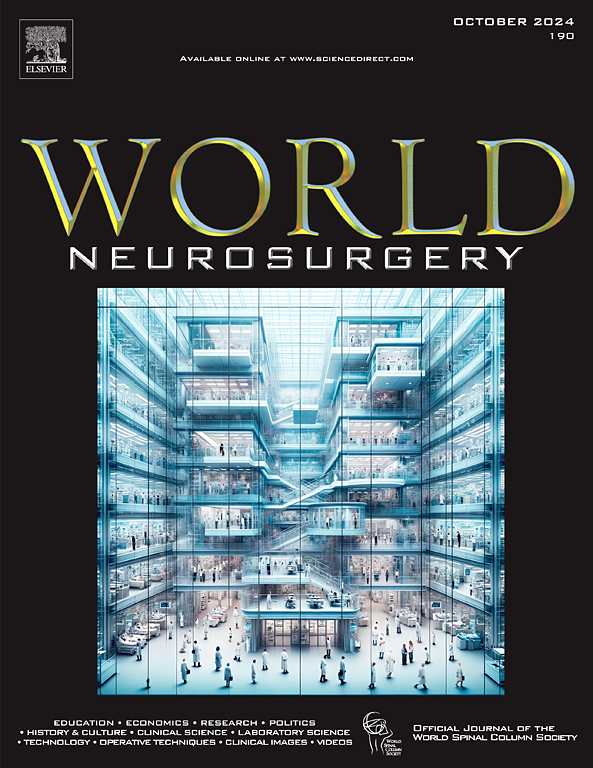日本在引入血流分流器时对未破裂的大型和巨大颈动脉海绵状动脉瘤的治疗:日本脑卒中外科协会全国多中心调查。
IF 1.9
4区 医学
Q3 CLINICAL NEUROLOGY
引用次数: 0
摘要
背景:除了传统的治疗方式外,血流分流器(FDs)已经被引入治疗大型或巨型海绵状颈动脉动脉瘤(CCAs),极大地改变了治疗策略。本研究的目的是通过一项全国调查来检查日本在fd引入时未破裂的大型/巨型cca的管理情况。方法:回顾性分析2012 - 2016年日本神经外科教学科室收治的540例未破裂大/巨型cca。结果:对较大的cca分别采用载动脉闭塞(PAO)、FD和栓塞治疗,而对巨大动脉瘤则主要采用PAO闭塞治疗。PAO与血运重建术在大多数情况下是联合的。最终随访时,PAO的几乎完全闭塞率(92.4%)高于FD(60.1%)和卷曲(70.3%),PAO治疗眼麻痹最有效。盘绕有较高的复发和再治疗风险。9.6%的患者出现手术相关的重大并发症。颅神经症状是最常见的并发症,盘绕的风险明显更高。所有治疗方式的临床效果均较好(92.1% ~ 96.1%);然而,观察到5例延迟破裂病例(PAO 1, FD 4),导致2例死亡(PAO 1, FD 1)。结论:本文报道的全国调查确定了FD引入时日本未破裂的大/巨型cca的治疗状况。由于PAO有缺点,包括ICA闭塞的长期血流动力学影响,使用FDs重建治疗是这种类型动脉瘤的最佳选择;然而,在某些情况下,由于完全闭塞和症状改善的比率较高,PAO可以作为一种选择。本文章由计算机程序翻译,如有差异,请以英文原文为准。
Treatment of Unruptured Large and Giant Carotid Cavernous Aneurysms in Japan at the Time of Flow Diverter Introduction: A Nationwide, Multicenter Survey by the Japanese Society on Surgery for Cerebral Stroke
Background
Flow diverters (FDs) were introduced for management of large or giant cavernous carotid aneurysms (CCAs) in addition to conventional modalities, dramatically changing treatment strategies. This study examined the management of unruptured large/giant CCAs in Japan when FDs were being introduced using a nationwide survey.
Methods
A total of 540 unruptured large/giant CCAs treated at neurosurgical teaching departments in Japan between 2012 and 2016 were retrospectively studied.
Results
Large CCAs were treated equally by parent artery occlusion (PAO), FD, and coiling, but giant aneurysms were occluded mainly by PAO. PAO was combined with revascularization in most cases. The nearly complete obliteration rate at final follow-up was higher after PAO (92.4%) than after FD (60.1%) and coiling (70.3%), and PAO was the most effective for ophthalmoparesis. Coiling had higher risks of recurrence and retreatment. Procedure-related major complications were observed in 9.6%. Cranial nerve symptoms were the most common complications, with coiling having significantly higher risks. All treatment modalities achieved good clinical outcomes (92.1%–96.1%); however, 5 delayed rupture cases were observed (1 PAO, 4 FD), resulting in 5 deaths (1 PAO, 1 FD).
Conclusions
The nationwide survey reported here determined the status of treatment for unruptured large/giant CCAs in Japan when FDs were being introduced. Because PAO has disadvantages including the long-term hemodynamic effects of ICA occlusion, reconstructive treatment using FDs is optimal for this type of aneurysm; however, PAO can be an option in selected cases given the higher rates of complete occlusion and symptom improvement.
求助全文
通过发布文献求助,成功后即可免费获取论文全文。
去求助
来源期刊

World neurosurgery
CLINICAL NEUROLOGY-SURGERY
CiteScore
3.90
自引率
15.00%
发文量
1765
审稿时长
47 days
期刊介绍:
World Neurosurgery has an open access mirror journal World Neurosurgery: X, sharing the same aims and scope, editorial team, submission system and rigorous peer review.
The journal''s mission is to:
-To provide a first-class international forum and a 2-way conduit for dialogue that is relevant to neurosurgeons and providers who care for neurosurgery patients. The categories of the exchanged information include clinical and basic science, as well as global information that provide social, political, educational, economic, cultural or societal insights and knowledge that are of significance and relevance to worldwide neurosurgery patient care.
-To act as a primary intellectual catalyst for the stimulation of creativity, the creation of new knowledge, and the enhancement of quality neurosurgical care worldwide.
-To provide a forum for communication that enriches the lives of all neurosurgeons and their colleagues; and, in so doing, enriches the lives of their patients.
Topics to be addressed in World Neurosurgery include: EDUCATION, ECONOMICS, RESEARCH, POLITICS, HISTORY, CULTURE, CLINICAL SCIENCE, LABORATORY SCIENCE, TECHNOLOGY, OPERATIVE TECHNIQUES, CLINICAL IMAGES, VIDEOS
 求助内容:
求助内容: 应助结果提醒方式:
应助结果提醒方式:


